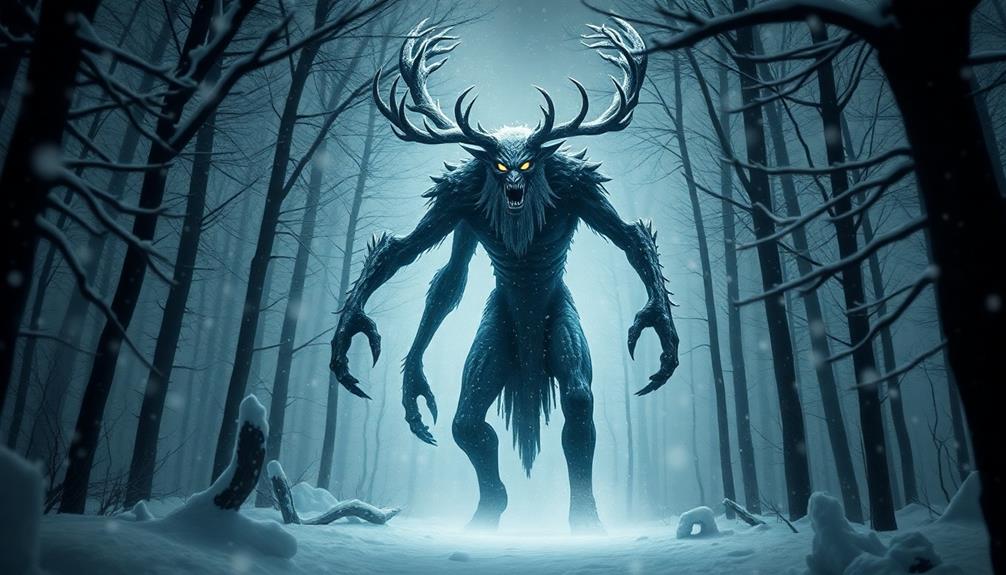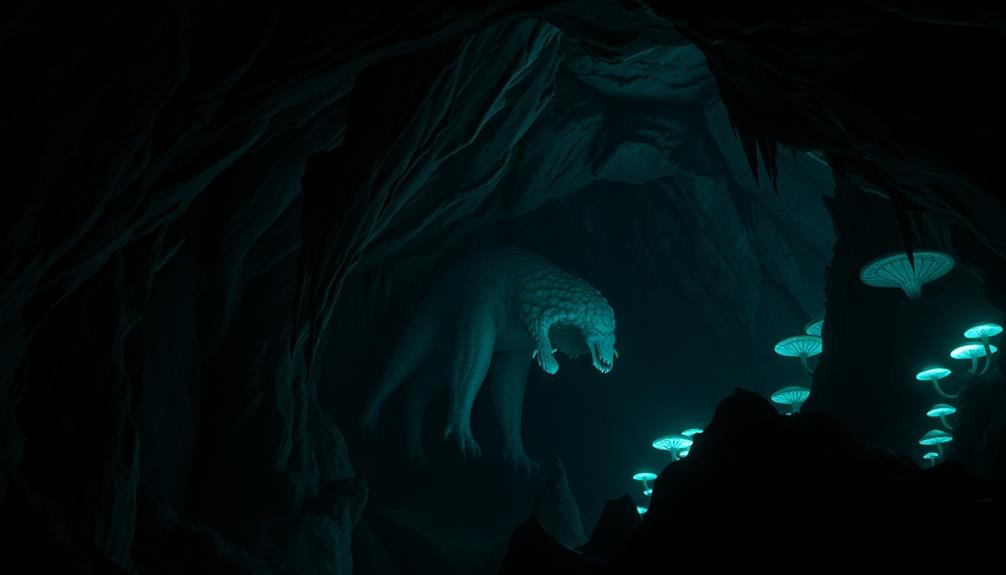If the Rougarou can pass its curse to others through a bite, it creates a chilling cycle of fear and moral dilemmas. You'd face the intense pressure of deciding whether to bite another and pass the curse or keep it yourself. This transformation not only alters your identity but also threatens your community, as the curse could spread rapidly. The legend emphasizes accountability and the consequences of breaking promises, especially during Lent. Every choice holds weight, which binds you to the shared folklore of the Rougarou. You might find that there's even more to uncover about the curse's impact on society.
Key Takeaways
- The Rougarou curse is transmitted through a bite, creating a 101-day countdown for the victim to pass it to another person.
- Victims must keep the identity of the Rougarou secret to avoid further consequences and maintain their own safety.
- Passing the curse alters the victim's identity, raising moral dilemmas about responsibility and the impact on their community connections.
- Decapitation can halt curse transmission, emphasizing community accountability and preventing the curse from spreading further.
- Rituals and clever tricks, like the "13-item trick," can confuse the curse and offer potential ways to break the cycle of transmission.
Origins of the Rougarou

The legend of the Rougarou, often described as a Louisiana werewolf, has its roots in the French term "loup-garou," brought to the region by 18th-century French settlers.
This folklore, rich in cultural influences, blends elements from French, Native American, and African traditions, creating a unique tale that resonates in Louisiana's heritage.
You might be intrigued to learn that the Rougarou is more than just a creature of the night; it embodies the consequences of failure.
According to the legend of the loup-garou, if someone breaks their Lenten vows for seven consecutive years, they could face transformation into this shape-shifting being.
This transformation isn't just a personal curse; it can extend to others.
The Rougarou has the power to pass its curse to another through its bite.
Once cursed, the individual has 101 days to regain their human form by transferring the curse to someone else.
The Rougarou legend serves as a cautionary tale, reminding you of the importance of keeping one's promises and the fate that could await those who don't.
Transformation and Curses

When you encounter a rougarou, a single bite can change your life forever, passing the curse onto you.
As night falls, you're thrust into a struggle for survival, facing the grim reality of hunting to reclaim your humanity.
Yet, there's hope—strategies like the mysterious 13-item trick could offer a way to break free from the curse's grip.
Curse Transmission Mechanism
Curse transmission in the lore of the rougarou hinges on a chilling mechanism: a bite from the cursed individual. In Louisiana folklore, this bite triggers a transformation, forcing the victim into a race against time. The original rougarou has 101 days to bite someone else before they revert back to human form, perpetuating the cycle of the curse.
| Factor | Details |
|---|---|
| Transmission Method | Bite from the original rougarou |
| Time Limit | 101 days to bite another to pass the curse |
| Excommunication Risk | Individuals excommunicated from the church are at greater risk of becoming a rougarou |
This curse is not just about the bite; it reflects deeper themes of sin and exclusion. Those deemed unworthy, like the excommunicated, face potential transformation into a beast. However, the curse can be lifted through clever tactics, like placing 13 identical items, or by decapitation, which halts the transmission. Understanding this curse transmission mechanism is crucial to grasp the haunting legacy of the rougarou.
Bite and Consequences
How does a single bite lead to such a terrifying transformation? When a rougarou sinks its teeth into you, you're not just facing a wound; you're accepting a curse. This bite initiates a harrowing process, transforming you into a rougarou after 101 days.
During this period, you must keep the identity of your attacker a secret, or risk further consequences. As you navigate through this torment, you become acutely aware of the weight of the curse. You're haunted by the knowledge that you, too, can pass this transformation to another through your own bite.
This cycle of fear continues as you grapple with the moral implications of your actions. The curse often symbolizes punishment, particularly for failing to observe Lent, linking it to local folklore and Voodoo practices.
You're left to contemplate your choices, knowing that this transformation isn't just physical—it's a shift in your very essence. The world around you changes as you ponder the possibility of biting another victim, thereby perpetuating the cycle.
The curse binds you, and every decision carries the weight of your new existence as a potential harbinger of doom.
Breaking the Curse
Breaking free from the grip of the Rougarou's curse isn't a straightforward task. If you find yourself bitten, you face an intimidating 101 days of transformation into this fearsome beast. The only way to break the curse, traditionally, involves passing it on by biting another person.
However, if you wish to escape without inflicting the curse on someone else, you'll need to employ some clever tactics. One effective method involves creating confusion. Gather 13 identical items and place them in front of the cursed individual. The Rougarou, unable to count past 13, will become perplexed, allowing you a chance to break the curse.
Additionally, it's worth noting that certain actions can lead to becoming a Rougarou. Failing to uphold Lenten vows or facing excommunication from the church historically resulted in this transformation, emphasizing the moral implications tied to the curse.
In a world where the Rougarou's curse can easily spread, understanding how to break it becomes essential. With the right strategies, you can find a way to reclaim your humanity and escape the dark fate of the Rougarou.
The Curse Transfer Process

When a rougarou bites someone, the transfer of its curse begins, setting off a chain reaction that can change a person's life forever. The victim inherits the curse and faces the impending transformation into a rougarou within 101 days, a countdown that looms over their daily life.
To avoid becoming the creature, they must keep their new identity secret for a year and a day or risk succumbing to the curse themselves.
This transformation isn't just a physical change; it's also tied to moral lessons. Folklore often associates the rougarou's curse with breaking a Lenten vow, presenting the creature as a punishment for transgressions. The bitten individual must navigate the complexities of their situation, feeling the weight of societal expectations and fears.
Interestingly, there are ways to reverse the curse. Utilizing confusion tactics, like placing 13 identical items to distract the rougarou, can potentially lift the burden.
This process reflects the dual nature of the curse: it acts as a warning and a reminder of accountability within the community. Ultimately, the curse of the rougarou transforms not just the individual but also their connection to those around them.
Cultural Impact of the Curse

The Rougarou curse influences community behavior by instilling a sense of fear that encourages adherence to local norms.
It serves as a moral lesson, reminding you that failing to observe traditions can lead to serious consequences.
Additionally, various rituals emerge as protective measures, showcasing how folklore intertwines with daily life and local beliefs.
Community Behavioral Influence
In Louisiana, the Rougarou curse acts as a powerful social tool that shapes community behavior. When someone gets bitten by a Rougarou, it's not just a personal misfortune; it serves as a grim reminder of the consequences of moral failures. This curse reinforces community standards, urging you and your neighbors to adhere to the values that bind you together. If you stray too far from these norms, you risk not only your reputation but also your very humanity.
Rougarou stories emphasize the importance of secrecy about one's identity, illustrating that revealing too much can lead to dire consequences, not just for you but for the whole community. The fear of becoming a Rougarou instills a culture of caution, compelling individuals to navigate their moral obligations carefully.
As you witness the effects of this curse within your community, you realize how it fosters compliance and shapes behavior. The threat of transformation into a monstrous being keeps everyone in check, ensuring that actions align with shared values.
Ultimately, the Rougarou curse acts as a powerful deterrent against wrongdoing, reinforcing the importance of community cohesion and moral integrity.
Folklore and Morality Lessons
Stories of the Rougarou not only serve as cautionary tales but also encapsulate deep-rooted morality lessons that resonate throughout Louisiana's cultural landscape.
The curse transfer, symbolized by the act of biting, underscores the consequences of moral transgressions. This mechanism warns you that your actions can affect not just yourself but others, reinforcing the importance of adhering to societal norms, especially during Lent.
Folklore figures like the Rougarou act as enforcers of morality, punishing those who stray from righteous paths.
Parents and elders often invoke the creature's curse to instill good behavior in children, using fear as a tool to guide them.
The narrative emphasizes the significance of discretion, as revealing the identity of someone cursed can lead to even greater consequences.
Rituals for Protection
Locals have developed various rituals to protect themselves from the Rougarou, blending folklore with practical customs. These rituals serve not only as protection against the curse but also as a way to preserve cultural heritage. One common practice involves placing 13 small objects at entryways, ensuring that the Rougarou, unable to count past 12, is thwarted.
| Item | Purpose | Belief |
|---|---|---|
| Small stones | Ward off the curse | Represents grounding and safety |
| Garlic | Repels supernatural beings | Known for its protective qualities |
| Silver coins | Enhances protection | Believed to ward off evil spirits |
| Twigs | Confuses the Rougarou | Entangles its path |
Additionally, silver is often incorporated into protective charms, as its properties are thought to guard against such supernatural threats. These rituals emphasize the importance of secrecy, too; revealing the identity of a Rougarou can lead to transformation, reinforcing community bonds around discretion. Through these rituals, locals not only seek protection from curses but also strengthen their cultural identity.
Modern Interpretations and Media

Modern portrayals of the Rougarou have taken on new life in contemporary media, blending traditional lore with fresh narratives. You'll find the Rougarou's curse often depicted as a potent force, transferable through a bite, reflecting themes of contagion and moral consequences. This modern interpretation deepens the horror, turning the creature into a symbol of fear capable of spreading its curse among unsuspecting victims.
In series like "Supernatural," the Rougarou's curse creates tension and drives character development, showcasing how folklore evolves in the face of contemporary storytelling. The creature's ability to pass on its curse invites viewers to ponder the implications of their actions and the potential for consequences in their own lives.
Furthermore, adaptations acknowledge that the curse can be lifted through certain actions, like confusing the Rougarou with 13 identical items. This adds layers to the folklore, making it not just a tale of fear but also one of cleverness and strategy.
Local festivals, such as the Rougarou Festival in Houma, highlight these modern interpretations, engaging the community and celebrating the creature's legacy in a way that resonates today.
Eyewitness Accounts and Folklore

Eyewitness accounts of the Rougarou bring the folklore to life, revealing how real people's experiences can shape and preserve these legends. Many describe a dark figure with glowing eyes lurking in the bayous, instilling a deep-seated fear in those who encounter it. From personal narratives, you'll find individuals recounting the chilling transformation from human to Rougarou, emphasizing its shape-shifting abilities.
Local legends often tell of individuals cursed after breaking a Lenten vow, reinforcing the belief that this curse can be passed through a bite. Cautionary tales abound, particularly aimed at children, warning them against misbehavior.
Here's a glimpse of these accounts:
| Key Aspect | Description |
|---|---|
| Sightings | Dark figure with glowing eyes |
| Transformations | Witnesses see humans change into Rougarous |
| Curses | Breaking vows leads to becoming a Rougarou |
| Cautionary Tales | Stories warning children about misbehavior |
| Oral Tradition | Variations add authenticity to encounters |
These anecdotes not only preserve the folklore but also keep the community connected through shared fears and lessons.
Moral Lessons in Rougarou Tales

Many Rougarou tales emphasize essential moral lessons, teaching communities about the importance of adhering to societal norms and religious practices. These stories often focus on the consequences of breaking rules, particularly during Lent, where straying from the path can lead to the dreaded curse of becoming a Rougarou.
By illustrating the creature as a punisher of transgressions, these narratives reinforce community values and highlight the need for accountability. You learn that your actions don't just affect you but ripple through your community. When someone misbehaves, they risk passing the curse to others, symbolizing how individual choices can impact the social fabric.
This interconnectedness serves as a powerful reminder: bad behavior can lead to dire consequences for everyone. Moreover, Rougarou legends inspire children to behave well, using fear as a tool for imparting moral lessons. The idea of becoming a Rougarou encourages obedience and respect for community values.
Ultimately, these tales serve as cautionary narratives, reminding you that adhering to societal norms isn't just about personal morality; it's about preserving the well-being of the entire community.
Comparisons to Other Legends

Rougarou tales not only impart moral lessons but also connect to a broader tapestry of legends that share similar themes of transformation and curses. The idea of transformation, particularly through a curse, is prevalent in many cultures. For instance, European werewolf legends, like the loup-garou, illustrate how a bite can create a chain reaction of transformation, just like the rougarou stems from a bite that passes its curse onto others.
This theme resonates with the emotional instability found in BPD dynamics in relationships, where intense connections can lead to tumultuous outcomes.
In Native American folklore, the skinwalker embodies this theme as a shapeshifter that can transfer its powers or curse, demonstrating that the fear of losing humanity isn't unique to any one culture.
Similarly, the Japanese yōkai known as the Jorōgumo ensnares victims, leading them to transformation or demise, echoing the rougarou's chilling narrative of curse transmission.
Even in African tales, the zombi can impose its curse on the living, further emphasizing the shared anxieties surrounding supernatural afflictions.
These legends highlight a universal concern: the peril of transformation through a curse, reminding us that the fear of losing our humanity resonates across cultures.
Community Responses to Sightings

When reports of rougarou sightings surface, communities often rally together, heightening their vigilance and caution. Locals warn their children to stay indoors after dark, ensuring the safety of the younger generation.
You might notice an uptick in personal anecdotes shared on social media and community forums, creating a culture of storytelling that keeps the rougarou legend alive.
Local events like the Rougarou Festival play a significant role in these community responses. They provide a space for discussion about sightings while reinforcing cultural pride and community ties.
You'll find residents engaging in protective rituals, such as placing 13 small items at their doors, believing this practice wards off the creature and protects them from the curse.
Interestingly, these sightings often spark increased tourism, with local businesses capitalizing on the rougarou's legendary status to attract visitors.
You might see shops selling themed merchandise or offering tours about the legend, further intertwining the community's identity with the lore.
Conclusion
In exploring the Rougarou's curse, you see tales of fear and fascination intertwine. You witness transformations that haunt the night, you hear whispers of curses that spread like wildfire, and you feel the weight of moral lessons echo through generations. The Rougarou isn't just a monster; it's a reflection of our anxieties, our beliefs, and our community bonds. As you ponder its legacy, remember: every story has a lesson, and every curse carries a warning.










